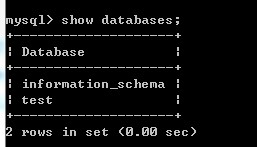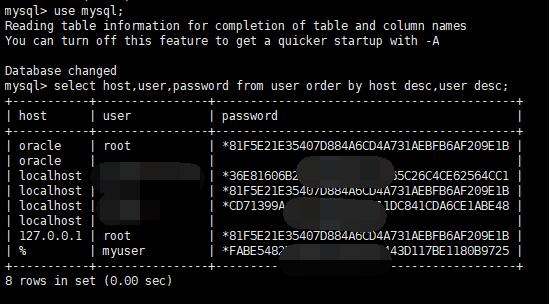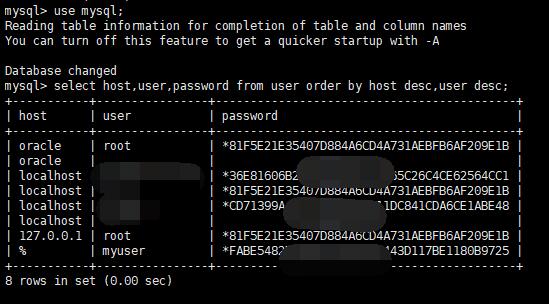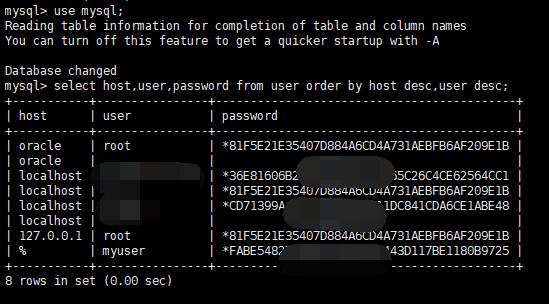Reasons for MySQL ERROR 1045 and how to solve it
When entering mysql -u root –p on the command line, entering the password, or connecting to the database through a tool, the following error message often appears. I believe many people have this error message. I have encountered this when using MySQL.
ERROR 1045 (28000): Access denied for user 'root'@'localhost' (using password: YES)
You can usually find solutions online
1. Stop the service
Stop the MySQL service;
# windows net stop mysql # linux service mysqld stop
2. Skip verification
Modify the my.ini configuration file in the MySQL installation directory so that Skip the permission check when logging in;
#到mysql根目录找到mysql配置文件 vim my.ini #在my.ini,[mysqld]下添加一行,使其登录时跳过权限检查 skip_grant_tables
3. Change password
Start the MySQL service and log in to MySQL. You will be prompted to enter a password. Enter any password and press Enter to enter MySQL.
#登录mysql mysql -u root -p
Then modify the password of the root user through SQL statements;
#将数据库切换至mysql库 mysql> USE mysql; #修改密码 mysql> UPDATE user SET password=PASSWORD(‘newpasswd')WHERE user='root'; #刷新MySQL权限相关的表 mysql> flush privileges; mysql> exit;
4. Restart the service
Delete or add the skip permission statement added to the my.ini file# Note.
Restart the service and log in with the modified password.
Cause Analysis
Use the root user to log in to MySQL and check the user information in the user table as follows. You can find that the host fields are % and localhost respectively.
mysql>select host,user,password from user;

In MySQL, '%' means that you can log in to the MySQL database on any host, so why do you need to explicitly create a user whose login host is localhost?
This involves the initialization user, anonymous user and connection verification strategy during MySQL installation.
Let’s conduct an in-depth analysis below.
When installing MySQL, some users will be initialized by default, such as the root user, and users whose host field is localhost and user field is empty.
The user whose User field is empty is an anonymous user, and the user's password is also empty. Anyone can use an anonymous user to log in to the MySQL database, but the things that can be done are limited, such as on the command line Directly enter mysql to log in, you can check which databases the anonymous user has permissions:
mysql>select current_user;

mysql>show databases;

You can find through the above picture that the anonymous user Only has permissions for information_schema and test database.
How do anonymous users affect the login of other users and cause the 28000 error?
When trying to connect to a MySQL database, the database decides whether to accept the connection request based on the provided identity and password. The identity consists of two parts: the user name and the client host (that is, the host where the mysql command is entered).
Since the % in the host field matches any host or the host field contains wildcards, multiple matching rows may appear, and the server must decide which one to match. The server reads the data in the user table into memory, according to the host and user fields to sort the rows.
mysql>select host,user,password from user order by host desc,user desc;

When the client attempts to connect, the server looks for the sorted rows and uses the first one that matches the client's host and username. After a matching row is found, Verify whether the passwords are consistent. If they are consistent, the login is successful.
If the user field is empty, it means that it can match any user.
Attention here:
user is empty, that is, any user. When logging in to localhost without a password, the anonymous user only has permissions for the information_schema and test database. Use other database, resulting in failure.

If the user is root, the password is displayed as empty, or the host field is displayed as non-’%', the default matching order will be followed, or a password error or prompt will be displayed. is ERROR 1045.
The picture below has been modified and is for reference only. For example, in the first sequence, if the host is localhost or the 127 loopback address, a 1045 error will occur.

SO Solution
mysql> select host,user,password from user order by host desc,user desc; ## 将排序序列中最前面的用户修改host为'%' mysql> update user set host = '%' where host = 'oracle' and user = 'root'; mysql> flush privileges;

The above is the detailed content of Reasons for MySQL ERROR 1045 and how to solve it. For more information, please follow other related articles on the PHP Chinese website!

Hot AI Tools

Undresser.AI Undress
AI-powered app for creating realistic nude photos

AI Clothes Remover
Online AI tool for removing clothes from photos.

Undress AI Tool
Undress images for free

Clothoff.io
AI clothes remover

Video Face Swap
Swap faces in any video effortlessly with our completely free AI face swap tool!

Hot Article

Hot Tools

Notepad++7.3.1
Easy-to-use and free code editor

SublimeText3 Chinese version
Chinese version, very easy to use

Zend Studio 13.0.1
Powerful PHP integrated development environment

Dreamweaver CS6
Visual web development tools

SublimeText3 Mac version
God-level code editing software (SublimeText3)

Hot Topics
 MySQL's Role: Databases in Web Applications
Apr 17, 2025 am 12:23 AM
MySQL's Role: Databases in Web Applications
Apr 17, 2025 am 12:23 AM
The main role of MySQL in web applications is to store and manage data. 1.MySQL efficiently processes user information, product catalogs, transaction records and other data. 2. Through SQL query, developers can extract information from the database to generate dynamic content. 3.MySQL works based on the client-server model to ensure acceptable query speed.
 How to start mysql by docker
Apr 15, 2025 pm 12:09 PM
How to start mysql by docker
Apr 15, 2025 pm 12:09 PM
The process of starting MySQL in Docker consists of the following steps: Pull the MySQL image to create and start the container, set the root user password, and map the port verification connection Create the database and the user grants all permissions to the database
 Laravel Introduction Example
Apr 18, 2025 pm 12:45 PM
Laravel Introduction Example
Apr 18, 2025 pm 12:45 PM
Laravel is a PHP framework for easy building of web applications. It provides a range of powerful features including: Installation: Install the Laravel CLI globally with Composer and create applications in the project directory. Routing: Define the relationship between the URL and the handler in routes/web.php. View: Create a view in resources/views to render the application's interface. Database Integration: Provides out-of-the-box integration with databases such as MySQL and uses migration to create and modify tables. Model and Controller: The model represents the database entity and the controller processes HTTP requests.
 Solve database connection problem: a practical case of using minii/db library
Apr 18, 2025 am 07:09 AM
Solve database connection problem: a practical case of using minii/db library
Apr 18, 2025 am 07:09 AM
I encountered a tricky problem when developing a small application: the need to quickly integrate a lightweight database operation library. After trying multiple libraries, I found that they either have too much functionality or are not very compatible. Eventually, I found minii/db, a simplified version based on Yii2 that solved my problem perfectly.
 How to install mysql in centos7
Apr 14, 2025 pm 08:30 PM
How to install mysql in centos7
Apr 14, 2025 pm 08:30 PM
The key to installing MySQL elegantly is to add the official MySQL repository. The specific steps are as follows: Download the MySQL official GPG key to prevent phishing attacks. Add MySQL repository file: rpm -Uvh https://dev.mysql.com/get/mysql80-community-release-el7-3.noarch.rpm Update yum repository cache: yum update installation MySQL: yum install mysql-server startup MySQL service: systemctl start mysqld set up booting
 Laravel framework installation method
Apr 18, 2025 pm 12:54 PM
Laravel framework installation method
Apr 18, 2025 pm 12:54 PM
Article summary: This article provides detailed step-by-step instructions to guide readers on how to easily install the Laravel framework. Laravel is a powerful PHP framework that speeds up the development process of web applications. This tutorial covers the installation process from system requirements to configuring databases and setting up routing. By following these steps, readers can quickly and efficiently lay a solid foundation for their Laravel project.
 MySQL and phpMyAdmin: Core Features and Functions
Apr 22, 2025 am 12:12 AM
MySQL and phpMyAdmin: Core Features and Functions
Apr 22, 2025 am 12:12 AM
MySQL and phpMyAdmin are powerful database management tools. 1) MySQL is used to create databases and tables, and to execute DML and SQL queries. 2) phpMyAdmin provides an intuitive interface for database management, table structure management, data operations and user permission management.
 Centos install mysql
Apr 14, 2025 pm 08:09 PM
Centos install mysql
Apr 14, 2025 pm 08:09 PM
Installing MySQL on CentOS involves the following steps: Adding the appropriate MySQL yum source. Execute the yum install mysql-server command to install the MySQL server. Use the mysql_secure_installation command to make security settings, such as setting the root user password. Customize the MySQL configuration file as needed. Tune MySQL parameters and optimize databases for performance.






